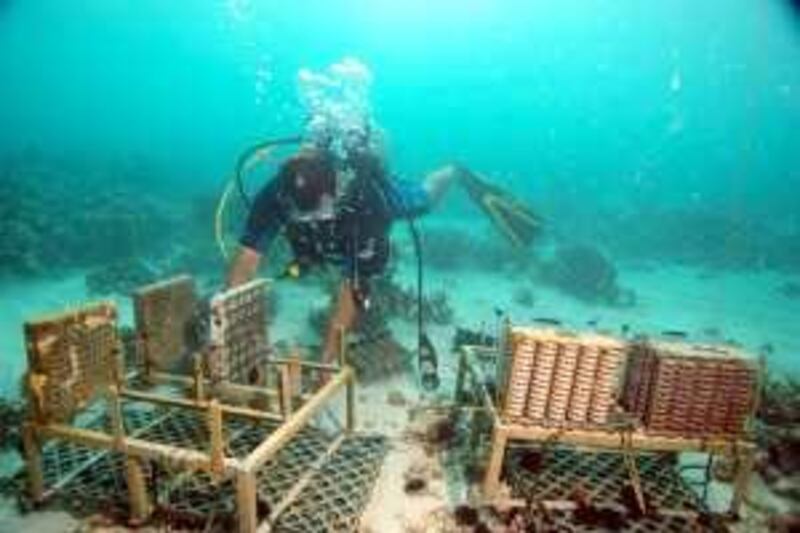ABU DHABI // Coral "condominiums" could start sprouting off Abu Dhabi's coast from stacks of tiny ceramic beds, if a joint coral rehabilitation programme between the Environment Agency-Abu Dhabi (EAD) and Japanese scientists succeeds. Researchers will dive this month at Saadiyat Island and Al Dhabeiyah to install dozens of the doughnut-sized discs, brought to the Emirates by Dr Mineo Okamoto of the Tokyo University for Marine Science and Technology.
Each of the porous "coral settlement devices" has grooves and crevices in which coral larvae can take root. "You build on the layers, and corals tend to settle between the small places," said Suaad al Harthi, a scientist with the EAD's coastal zone management section. "Like condominiums." Over time, individual discs showing juvenile coral growth can be disassembled and installed at other locations to revive dying reefs.
"There's the potential to actually take the corals and put them in nurseries, grow them for a while and transplant them in certain areas that have been damaged," she said. The first installation was in March. An expedition is planned for each month. The next dive is scheduled for May 20. "We targeted the dates of the lunar cycle," said Ashraf al Cibahy, the EAD's manager for marine protected areas. "Corals spawn and lay eggs during full moonlight, so we targeted the lunar days of March and now May."
Mr al Cibahy displayed one of the ceramic discs taken from the seabed in Okinawa. Small sprigs of staghorn coral branched out. "This was after maybe more than one year, maybe two years," he said. "The growth rate here is maybe higher than other seas." Unlike previous projects that created artificial reefs from cement "reef balls" dropped into the sea, Mr al Cibahy said the focus here was not to mimic living coral but to grow more. The Japanese discs are made from calcium carbonate, the same chemical that makes up the "skeleton" of coral.
Japan's coral rehabilitation project, conducted years earlier to restore the Okinawa reef, has shown promising results, Ms al Harthi said. Even so, it is difficult to predict whether it will show similar results here; Abu Dhabi's waters are warmer and have a higher salinity. "We have general information that our corals can grow a little bit more than 1cm per year," Mr al Cibahy said. The hot water of the Arabian Gulf - above 35°C in summer - makes it suprising that coral grows so well here, according to Dr John Burt, a marine biologist with the New York University-Abu Dhabi.
"It is very much an anomaly here that we have corals living in these extreme conditions," he said. "The story here is coral lives well in excess of protected reefs elsewhere, so there may be a story of hope here for reefs in other areas if coral can acclimate, adapt. It's possible that the reefs in this area may seed other areas in the future either through natural means or human intervention." @Email:mkwong@thenational.ae





